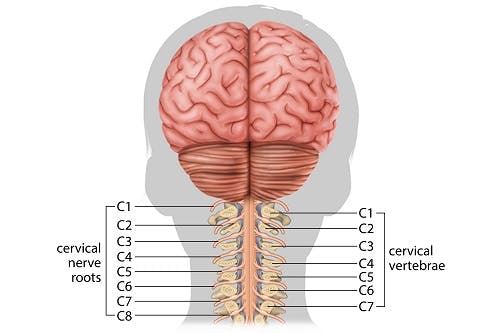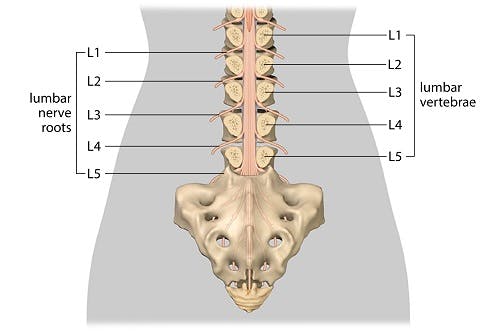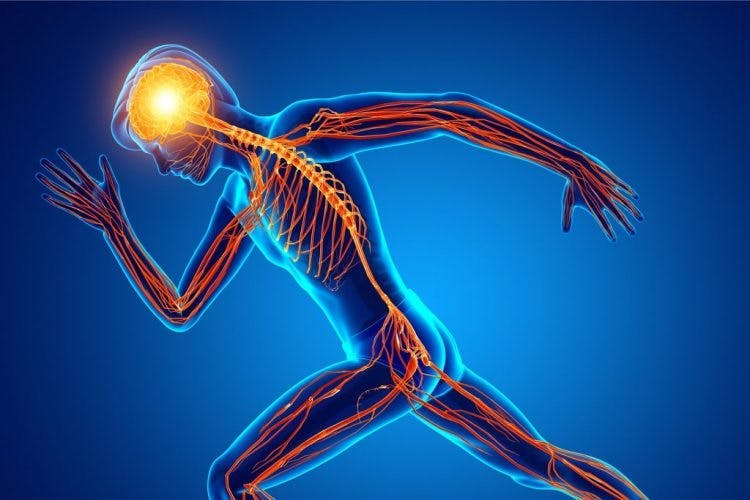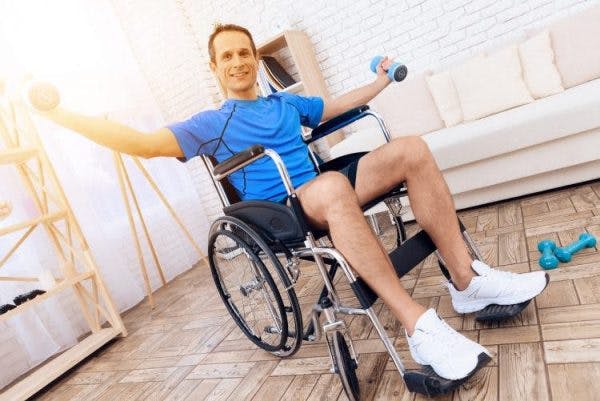The level of a spinal cord injury refers to the lowest region of the spinal cord where normal motor control and sensation exist. Knowing one’s level of injury helps individuals determine which functions the injury may affect.
To help you understand each of the spinal cord injury levels, this article will discuss:
- What your level of injury means
- Anatomy of the spinal cord before injury
- Cervical SCI
- Thoracic SCI
- Lumbar SCI
- Sacral SCI
- Coccygeal SCI
How the Level of Spinal Cord Injury Affects Movement and Sensation
The spinal cord is the neural passageway that allows for communication between the brain and body. A spinal cord injury disrupts that connection, preventing areas below the injury from effectively sending or receiving communication from the brain.
The spinal cord in particular is essential for the functions of movement and sensation. As such, common complications of spinal cord injury involve paralysis and/or changes in sensation, such as numbness.
To determine which secondary effects may occur, it is essential to understand your level of spinal cord injury.
When determining your level of injury, a physician will test your sensory and motor functions using the International Standards for Neurological Classification of Spinal Cord Injury (ISNCSCI), also called the ASIA exam.
Each level of the spinal cord sends motor signals from the brain to different muscles throughout the body. We call the muscles designated to each level of the spinal cord myotomes.
Additionally, each level of the spinal cord receives sensory information from a different area of skin called a dermatome. This information travels through the spinal cord to the brain for processing and to allow the brain to decide how to appropriately respond.
In the next section, you’ll learn more about how different spinal cord injury levels affect different dermatomes and myotomes and, as a result, affect sensation and movement. Before we get there, let’s discuss the anatomy of the spinal column.
Anatomy of the Spinal Cord Before Injury

The spine, composed of 33 vertebrae, protects the spinal cord. Spinal nerves branch out from the spinal cord and exit above or below their corresponding vertebrae.
For each spinal cord level, there is a pair of spinal nerves (31 pairs in total), with one nerve going to the left side of the body and one going to the right. Furthermore, each spinal nerve contains a sensory nerve root that sends messages from the body to the brain, and a motor nerve root that sends messages from the brain to the corresponding area of the body.
Additionally, we divide the spinal cord into five regions (from top to bottom):
- Cervical
- Thoracic
- Lumbar
- Sacral
- Coccygeal
Motor signals from the brain and sensory signals from the body cannot travel past damaged regions of the spinal cord. As a result, a spinal cord injury may affect all motor functions and sensations innervated below its level, depending on its severity.
If the spinal cord is completely severed, doctors classify it as a complete spinal cord injury. If some connections remain intact, they classify it as an incomplete spinal cord injury. A higher level of injury and a more complete injury affect more functions.
In the next section, we’ll explain what functions each spinal cord injury level affects.
Cervical Level of Spinal Cord Injury

The cervical region of the spinal cord consists of 7 vertebrae and 8 cervical nerve roots in the neck area. Cervical spinal cord injuries are the most prevalent, making up nearly 60% of all SCIs. They also tend to be the most debilitating because the injury can potentially affect the entire body.
Complete cervical spinal cord injuries result in quadriplegia, which describes paralysis in both the upper and lower limbs.
Want 15 pages of SCI recovery exercises in PDF form? Click here to download our free SCI Rehab Exercise ebook now (link opens a pop up for uninterrupted reading)
Here are the functions that correspond with each specific level of cervical spinal cord injury.
Cervical Spinal Cord Injury: What Functions are Affected?
- C1 spinal cord injury – can affect most sensory and motor functions throughout the body.
- C2 spinal cord injury – may still have some motion of the neck, while the rest of the body may be paralyzed. Sensation in the back of the head, ears, and upper area of the neck are intact.
- C3 spinal cord injury – can affect your ability to breathe and may require a ventilator, at least initially. This is because the C3-C5 nerve roots innervate the diaphragm, which is essential for breathing. Those with a C3 SCI will be able to move and feel the majority of the neck.
- C4 spinal cord injury – may also affect breathing. However, those with a C4 SCI are able to raise their shoulders and have sensation in the shoulders, upper back, and upper chest.
- C5 spinal cord injury – will have intact sensation at the outer area of the upper arm and the ability to raise the arm to the side (shoulder abduction) and bend the elbows (elbow flexion). However, breathing can still be affected.
- C6 spinal cord injury –sensation at the outer forearms down to the thumbs and part of the index fingers will be intact. Wrist extension will also be intact, allowing grasping to be possible through a technique called tenodesis.
- C7 spinal cord injury – increasing sensation in the hand, including intact sensation of the middle finger. Those with a C7 SCI will be able to straighten the elbows and bend the wrists.
- C8 spinal cord injury – will be able to bend the fingers and grasp objects. Sensation and most movement in the hand will be intact at this level of injury. It’s worth noting that there is no C8 vertebrae. Thus, the C8 level of spinal cord injury refers to injury at the C8 nerve root.
Learn more about cervical spinal cord injuries »
Thoracic Level of Spinal Cord Injury

Below the cervical region is the thoracic region of the spinal cord. This region of the spinal cord consists of 12 levels.
Thoracic-level spinal cord injuries primarily affect sensation in the trunk and abdomen, as well as the muscles that make up your trunk and chest. As a result, individuals may experience difficulties with balance, posture, breathing, and coughing. Thoracic spinal cord injuries may also affect innervation of important organs, including the lungs, heart, liver, and small intestine.
Because the thoracic region is located below the cervical region, all functions corresponding to the cervical region remain intact. Therefore, individuals with SCIs below the T1 level should be able to use their hands and arms normally.

The lowermost functions left intact at each level of thoracic spinal cord injury include:
- T1 spinal cord injury – intact sensation of the inner forearm and the ability to separate your fingers (finger abduction).
- T2 spinal cord injury – the uppermost chest muscles and sensation near the armpit and upper chest are intact.
- T3, T4 and T5 spinal cord injury – intact sensation at the back, as well as in the upper, mid, and low chest respectively. Intercostal muscles, which are located between the ribs and play a key role in breathing, are often affected during T3-T5 spinal cord injury.
- T6 spinal cord injury through T12 spinal cord injury– can affect the abdominal muscles as well as sensation in the abdomen and low back. A T6 spinal cord injury will leave sensation intact at the top of the abdomen. Lower level thoracic injuries result in sensation deficits in progressively lower areas of the abdomen and low back. For reference, those with a T10 spinal cord injury generally have intact sensation down to the level of the belly button.
Learn more about thoracic spinal cord injuries »
Lumbar Level of Spinal Cord Injury

Following the thoracic region is the lumbar region. This region of the spinal cord consists of 5 levels.
Lumbar spinal cord injuries only affect the lower body, so individuals should have unaffected motor control and sensation in their hands, arms, and trunk. Because individuals with lumbar spinal cord injuries experience weakness or paralysis in their legs, they may struggle with walking and balance.
The lowermost functions left intact at each level of the lumbar spinal cord injury include:
- L1 spinal cord injury – will have sensation at the pelvic region, as well as the ability to flex the trunk. Those with a L1 spinal cord injury will have minimal hip movement. Functions of the legs may still be affected.
- L2 spinal cord injury – will be able to use the hip flexors, which are the muscles near the top of the thighs that allow you to raise your upper legs (such as during walking or marching). Sensation of the upper thighs will also be intact.
- L3 spinal cord injury – will have sensation at the lower thighs and knees and the ability to straighten the knees (knee extension).
- L4 spinal cord injury – will be able to lift the foot upwards (ankle dorsiflexion) as well as feel of the front and inner regions of the lower legs.
- L5 spinal cord injury – will be able to bend and straighten the big toe and have sensation of the front and outer areas of the lower legs down to the big, second, and middle toes.
Learn more about lumbar spinal cord injuries »
Sacral Spinal Cord Injury
The sacral region of the spinal cord consists of 5 levels. Individuals with sacral-level spinal cord injuries have unaffected upper body functions and partial leg functions.
Because bowel and bladder functions are innervated by the bottommost segments of the sacral spinal cord, individuals with nearly any level of spinal cord injury are likely to experience bowel and bladder problems.
The functions left intact at each level of the sacral region of the spinal cord include:
- S1 spinal cord injury – will have sensation at the fourth and pinky toes, heel, and part of the calf. Those with an S1 spinal cord injury can also extend the ankle so that the foot points down (ankle plantarflexion).
- S2 spinal cord injury – will have sensation in most areas of the back of the legs, as well as the ability to bend the knees (knee flexion). The S2, S3, and S4 spinal nerves innervate the pelvic cavity, which is responsible for sexual, bladder, and bowel-related functions. Therefore, these functions may be more or less affected, depending on the level of injury.
- S3 spinal cord injury – will have sensation around the medial buttocks.
- S4 and S5 spinal cord injury – some functions within the perianal area may be left intact.
Coccygeal Level Spinal Cord Injury
At the very end of the spinal cord is a single coccygeal nerve. This nerve innervates the skin around the tailbone. As a result, individuals may experience pain, discomfort, or complete loss of sensation in the tailbone area.
However, because this nerve makes up the lowest level of the spinal cord, individuals should have normal motor control and sensation throughout most of their bodies.
Understanding Spinal Cord Injury Levels and Functions
Functional loss after spinal cord injury depends on the severity and level of injury. The severity of your SCI will determine to what extent functions innervated below your level of injury are affected. Likewise, the level of injury will determine which functions may or may not be affected.
We hope this article helped you better understand spinal cord injury levels and what sensorimotor functions may be impacted.











